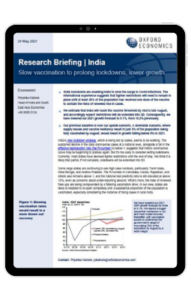India | Slow vaccination to prolong lockdowns, lower growth

India’s new lockdown strategy, which is being led by states, seems to be working. The sustained decline in the daily coronavirus cases at a national level, alongside a fall in the effective reproduction rate, suggests that India’s coronavirus curve may be beginning to plateau again. But it’s too early to consider exiting lockdowns. Currently, most states have decreed tighter restrictions until the end of May. We think it is likely that partial, if not complete, lockdowns will be extended into Q3.
What you will learn from this report:
- State lockdowns are enabling India to slow the surge in Covid infections. The international experience suggests that tighter restrictions will need to remain in place until at least 28% of the population has received one dose of the vaccine to contain the risks of renewed rise in cases.
- We estimate that India will reach the vaccine threshold by mid to late August, and accordingly expect restrictions will be extended into Q3. Consequently, we have lowered our 2021 growth forecast to 9.1%, from 10.2% previously.
- Our previous baseline is now our upside scenario. A downside scenario, where supply issues and vaccine hesitancy result in just 5% of the population being fully vaccinated by August, would result in growth falling below 8% in 2021.
Tags:
Related Services

Post
US Key Themes 2026: Exceptionalism amid fragmentation
US exceptionalism is alive and well, and that won't change in 2026.
Find Out More
Post
Global Key themes 2026: Bullish on US despite AI bubble fears
We anticipate another year of broadly steady and unexceptional global GDP growth, but with some more interesting stories running below the surface.
Find Out More